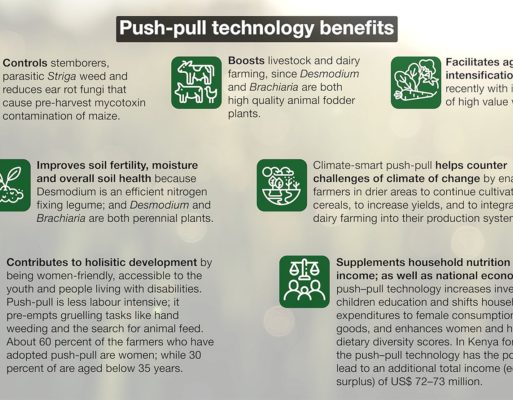
New study unravels the mechanisms through which the icipe push-pull technology conquers the fall armyworm, currently one of the most devastating and difficult pests in Africa
In 2016, the fall armyworm, a destructive moth that causes devastating damage to over 100 plant species, including cereals and horticultural crops, was reported for the first time in Africa. Initially confirmed in Nigeria, the pest has spread rapidly, rampaging its way across the continent, defying most control attempts, leaving farmers, governments and other stakeholders helpless. So intense and relentless is the pest’s damage that some countries, like Rwanda, incorporated defence forces into its management. By 2020, the fall armyworm had caused an average annual loss of 36 percent in maize production alone; and a total economic loss of USD 200 million, in Africa.
In 2017, the push-pull technology, developed by the International Centre of Insect Physiology and Ecology (icipe), Rothamsted Research, United Kingdom, and partners in East Africa, became the first documented, readily available technology that could efficiently manage the fall armyworm in an environmentally friendly and cost-effective manner. Push-pull’s capacity to control the fall armyworm was originally based on observations by farmers. These reports were confirmed through field evaluations and socio-economic assessments by icipe researchers, which showed fall armyworm infestation to be 80 percent lower in plots where the push-pull technology was being used, compared to monocropped maize plots.
Now, a study by icipe and Keele University, UK, published in Frontiers in Ecology and Evolution (paper link), has established the scientific mechanisms through which the push-pull technology conquers the fall armyworm. The findings also reveal intriguing new properties that reaffirm push-pull as a rare agricultural innovation success; its superiority as an agroecological technology that exploits natural insect–plant and insect–insect interactions; and its distinction as a platform to improve cereal-livestock mixed farming systems. (Watch short video: )
“Plants emit a range of unique odours. Over time, insect pests have evolved mechanisms to use these signals to locate suitable plants to feed on, and the most optimum egg-laying sites on the plants,” explains Amanuel Tamiru, icipe scientist, and one of the lead authors of the study. He adds: “Once plants are attacked by pests, they release chemical compounds in an attempt to defend themselves. However, these efforts by the plants are not always effective as in many cases the pest population is by then already entrenched.”
Originally developed for the control of stemborer pests, the push-pull technology involves intercropping cereal crops with plants, for example legumes of the Desmodium genus, which continuously produce defence odours even in the absence of pest attack. These defence compounds repel (push) stemborer moths from the target food crop. In addition, a fodder grass, for instance Brachiaria, is planted as a border crop, and it releases chemicals that attract (pull) and trap the stemborers. As a result, the cereal crop is protected from the pests. Furthermore, Desmodium also suppresses the parasitic Striga weed. The legume produces two sets of compounds: one that stimulates the germination of Striga seeds and another that inhibits their growth after germination. Currently, a climate-smart push-pull incorporates Greenleaf desmodium (Desmodium intortum) as an intercrop and Brachiaria cv Mulato II as a border crop. Push-pull also improves soil fertility and reduces mycotoxins contamination, a major food safety hazard. (*See comprehensive list of push-pull benefits on page 3)
 The recent study by icipe and Keele University shows that, just like in stemborer control, Desmodium acts as a push plant against the fall armyworm. It releases chemical scents that ward off the pest’s moths, preventing them from laying eggs on the cereal crop. Thus, the chances of the pest’s populations to build up are reduced.
The recent study by icipe and Keele University shows that, just like in stemborer control, Desmodium acts as a push plant against the fall armyworm. It releases chemical scents that ward off the pest’s moths, preventing them from laying eggs on the cereal crop. Thus, the chances of the pest’s populations to build up are reduced.
“Surprisingly, we found that unlike in the previous case where it serves as a ‘pull’, the border plant, Brachiaria, functions as a ‘push’ plant that also repels the fall armyworm pests,“ says Prof. Toby Bruce of Keele University and also a co-lead author of the study. “Even more interesting, we noted that both Desmodium and Brachiaria emit chemicals that attract (pull) natural enemies of the fall armyworm.”
“This is the first comprehensive study that reveals the underpinning mechanism of how push-pull companion crops help to manage the devastating fall armyworm. Our findings also provide further evidence that push-pull has far wider utility beyond its original goal of controlling stemborers, and thus, the technology’s huge potential in improving food security in Africa,” says Islam Sobhy, formerly Research Associate in Chemical Ecology, Keele University.
This new knowledge will enable icipe and partners to continue to implement a pest management package for the fall armyworm, integrating: the push–pull technology; natural enemies; biopesticides; and cereal varieties that are resistant to the pest, which have been identified in previous icipe research.
Further, these findings advance global knowledge on exploiting insect behaviour and stimulation and deterrent approaches in pest control. Such strategies are not new to science. But, in contrast to other studies that often target a single chemical and stage in the life cycle of pests, the push-pull research investigates a broader range of behaviour-affecting chemicals produced by a variety of plants, making resistance development by insects difficult. In addition, the push-pull technology does not use synthetic deterrents or toxins; it purely exploits plant-drived natural stimuli to manipulate pests.
“The ability of push-pull to manage such a devastating and difficult pest as the fall armyworm clearly demonstrates the utility of the technology as a platform in addressing the multitude of challenges that affect cereal-livestock farming systems in Africa. icipe intends to continue disseminating the technology as widely as possible across Africa, to enable farmers benefit ,” says Dr Segenet Kelemu, Director General & CEO, icipe.








